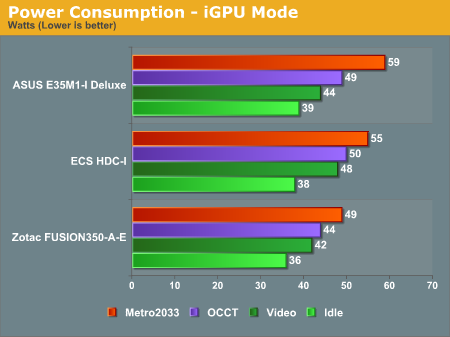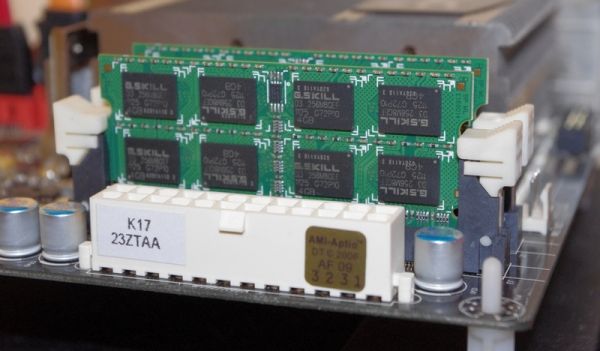Fusion E-350 Review: ASUS E35M1-I Deluxe, ECS HDC-I and Zotac FUSION350-A-E
by Ian Cutress on July 14, 2011 11:00 AM ESTTest Setup
| Processor |
AMD Fusion E-350 2 Cores, 2 Threads, 1.6 GHz |
| Motherboards |
ASUS E35M1-I Deluxe ECS HDC-I Zotac FUSION350-A-E |
| Cooling | Onboard |
| Power Supply | Silverstone 80 PLUS Silver |
| Memory |
G.Skill Sniper DDR3-1600 9-9-9-24 2x4GB Kit, 1.25V G.Skill SODIMM DDR3-1066 9-9-9-24 2x4GB Kit 1.5V |
| Memory Settings | Auto |
| Video Cards |
XFX HD 5850 1GB ECS GTX 580 1536MB |
| Video Drivers |
Catalyst 10.12 NVIDIA Drivers 275.33 |
| Hard Drive | Micron RealSSD C300 256GB |
| Optical Drive | LG GH22NS50 |
| Case | Open Test Bed - CoolerMaster Lab V1.0 |
| Operating System | Windows 7 64-bit |
| SATA Testing | Micron RealSSD C300 256GB |
| USB 2/3 Testing | Patriot 64GB SuperSonic USB 3.0 |
Many thanks to...
G.Skill have happily provided us with a set of their low voltage, gamer oriented, Sniper series DDR3 memory for this a future reviews, where low power usage may be of interest to the consumer. This 2x4 GB kit (D3-12800CL9D-8GBSR2) runs at 1600 MHz speeds with 9-9-9-24 2N timings at 1.25 V, and is currently available for $90.
What's actually interesting for me is to see how the power consumption readings change when going from normal 1.5 V memory, to the low voltage 1.25 V stuff. Technically we should see a power drop, but after playing around with the ASUS board in this review and the memory, the most I could predict (with general power levels fluctuating +/- 1 W as you would expect) is 1-2W maximum saving, if any at all. Over a year, it's true it's not that much power, and in a 60W system we're only talking 1% - it's more of a tool to say that people are being energy conscious (in my view).
G.Skill have also supplied us with a set of DDR3-1066 C9 SO-DIMM for the Zotac board review. This 2x4GB kit (F3-10666CL9D-8GBSQ) runs at 1066 Mhz with 9-9-9-24 timings at 1.5 V, and is currently available for $63.
Comparison to Previous Results
Where applicable, the results in this review are directly compared to the following chipsets and boards which we have reviewed previously:
Power Consumption

The Zotac scores best across the board in terms of power consumption.
(Note: I was using a less than ideal power supply for the power draw tests which was very inefficient in this range (<20% of maximum power), and unfortunately I don't have anything more appropriate at hand to test with. The comparisons (I believe) between the boards are more than relevant though. I will hopefully rectify this in future reviews of lower powered systems.)
CPU Temperatures

Given that both the Zotac and the ASUS boards are passive, you would expect their temperatures across the board to be higher than that of the ECS. However, the ECS has a small heatsink, meaning at idle the CPU is actually quite warm, and the fan spins up according to the temperature. Given a flat 45 Celsius from the ECS, I redid the tests by cooling the heatsink with other fans, removing them, and letting it warm up at idle, and ended with the same result. Overall, the Zotac performs the best out of these three.












67 Comments
View All Comments
sprockkets - Thursday, July 14, 2011 - link
I have the AsRock board. I get 18w idle and 24w under load via a killawatt device. Granted it uses an 80w power supply, but I'm kinda wondering how you got 59w for something that is practically the same setup in each board.IanCutress - Thursday, July 14, 2011 - link
I was using a less than ideal power supply for the power draw tests which was very inefficient in this range (<20% of maximum power), and unfortunately I don't have anything more appropriate at hand to test with. The comparisons (I believe) between the boards are more than relevant though. I will hopefully rectify this in future reviews of lower powered systems.Ian
formulav8 - Thursday, July 14, 2011 - link
Why didn't you wait to do power consumption tests then?bah12 - Thursday, July 14, 2011 - link
While not ideal, I'd say the whole point of this article was to illustrate the differences in the boards. Thus as long as they all suffered from the same inefficient PS, the information is not useless in that you can still draw a conclusion based on the differences at the board level. All and all, not ideal but useful.BushLin - Friday, July 15, 2011 - link
I once tried to reason with the fanboys at AMDZone on Anands behalf, defending that the reviews here were objective... I think I'm starting to believe that their might be some truth in their beliefs that the odds are stacked against AMD when their products are reviewed on here.At best, this review is a misguided. It focuses far too heavily on areas these systems are not aimed at, misinforms (or fails to inform) on areas that it's market are interested in and answers stupid questions that no-one is asking. Testing a GTX 580 with an E-350 at 4x PCI-E... really? Why not test out how well these work as a HTPC compared to something like ION and the latest Atom?
At worst, this review could almost be seen as a deliberate undermining of a technology that's potentially superior to it's Intel's offering and how often could you honestly say that since Core2?. Most of the tests are irrelevant (or become irrelevant when comparing to much higher TDP chips), the one test you did manage to do which is very relevant (power consumption) was so high that it prompted me to look at other reviews and take the time to write this comment!
This review has idle power consumption as at least 36w, Xbit have it at 7.3w even with a 880w PSU. One of these reviews has it very wrong, I know which one I'm more inclined to believe.
http://www.xbitlabs.com/articles/cpu/display/amd-e...
IKeelU - Friday, July 15, 2011 - link
I have to agree with your assessment of the review.- These boards are aimed at HTPC market, but the review was focused...elsewhere (frankly, I can't tell what the focus was).
- How is the audio quality? I was very interested in the ASUS board until I noticed it doesn't have 6-channel direct out. This is important!
- Another, less important, point: The features/specs for each board should come first. Double points for a feature comparison table.
AnandThenMan - Friday, July 15, 2011 - link
It is extremely unfortunate that Anandtech has sacrificed their integrity when it comes to reviewing some of AMD's products. I really hope that more and more people are made aware of what is going on, these reviews are downright dishonest.The most important question people need to ask is, why is this happening? What is the incentive for Anandtech.com to publish these misleading reviews?
ET - Saturday, July 16, 2011 - link
Can you explain what is dishonest or misleading about this review? I agree that it could be better, but I don't see anything to indicate that anything was falsified here.medi01 - Sunday, July 17, 2011 - link
Seriously?Cough "This review has idle power consumption as at least 36w, Xbit have it at 7.3w even with a 880w PSU. ", cough?
Oh, it's irrelevant, because we're comparing motherboards of the same platform? Orly? What if I read this, say "OMG it consumes so much energy" and go buy Atom?
Tell me how to get that 36w idle thing, what kind of PSU should be used, to justify 7.3w (with bloody 880w PSU!!!!) vs 36w please?
What are 5850 580gtx doing in this review?
Shameless...
Finraziel - Thursday, September 1, 2011 - link
Monstrously late reply... but I just can't not leave this comment... Did any of you actually read the xbit article? Those power draw measurements are measured between the PSU and the components, only measuring what the components are actually using, completely ignoring the efficiency of the PSU (the way xbitlabs has been testing for years I might add). So the fact that they were using an 880W PSU has absolutely zero bearing on their readings.Granted, it's still a shame that these boards couldn't have been tested with something like a pico psu, and I do agree the article could have been better (for instance, how much noise does that tiny fan on the ECS board actually make? apart from an easily missed remark in the conclusion nothing is said about it), but it's not as bad as you people are making it out to be.